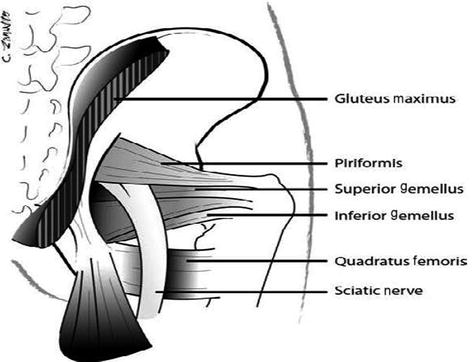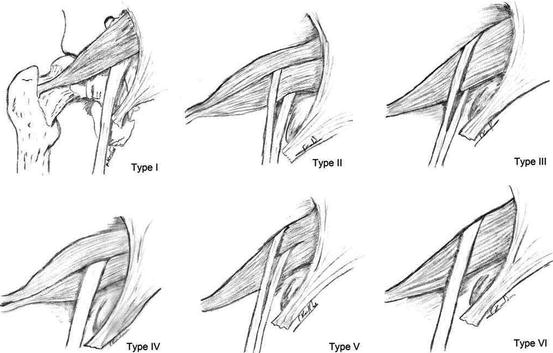(1)
Botulinum Toxin Treatment Program, Yale School of Medicine, New Haven, CT, USA
Abstract
Piriformis syndrome is characterized by chronic buttock pain exacerbated by long periods of sitting. It is believed to be due to the irritation of nearby sciatic nerve (or one of its major divisions) by a tense and overactive piriformis muscle. Current treatments consist of stretching exercises, oral medications, and anesthetic or steroid injections; these approaches are only partially effective. Two double-blind, placebo-controlled studies have strongly supported the efficacy of onabotulinumtoxinA in management of piriformis syndrome. Two comparator studies favored onabotulinumtoxinA and abobotulinumtoxinA treatment over steroid injections in respect to both pain relief and duration of relief in piriformis syndrome. Limited open studies suggest that type B toxin (rimaB) is also effective. Botulinum neurotoxins provide a safe and effective treatment for relief of pain in piriformis syndrome.
Keywords
Botulinum toxinBotulinum neurotoxinOnabotulinumtoxinAAbobotulinumtoxinARimabotulinumtoxinBPiriformis syndromeIntroduction
Piriformis syndrome (PS) is defined as a clinical condition characterized by irritation of the sciatic nerve caused by a tense and overactive piriformis muscle. The term piriformis syndrome was coined in 1947 by Robinson. Due to the difficulty in finding an exact pathology in many patients and lack of clear neuroimaging and electrophysiological data, some specialists have challenged the existence of this syndrome (Stewart 2003; Tiel 2008). It is currently believed, however, that the syndrome exists and is a cause of buttock pain and sciatica.
The true incidence of piriformis syndrome is not known. One investigator estimated that 6 % of all cases of sciatica represent PS (Hallin 1983). Based on this estimate, PS would affect a large number of people in the USA annually and, hence, pose a significant challenge for clinicians.
The factors that cause tension and contraction of the piriformis muscle, in most cases, are unknown. Trauma to the pelvis and gluteal area is considered a plausible etiology. Less common causes include disease of the sacroiliac joint, intragluteal injections, myositis, hematoma, abscess, regional neoplasm, hypertrophy, and spasm of the piriformis muscle. Pain is the major symptom and it is often present during sitting or squatting. The pain mainly felt in the buttock may radiate down the thigh, or it may be felt in the low back region. On examination, pressure over the area of the sciatic notch may induce pain. In a review of 50 previously published papers on piriformis syndrome, Hopayian et al. (2010) found buttock pain (50–95 %), pain aggravated by sitting (39–97 %), and external tenderness near the greater sciatic notch (59–92 %) as the most common presenting symptoms of the syndrome. The “piriformis sign” is described as a tonic external rotation of the leg and is observed in 38.5 % of the patients (Durrani and Winnie 1991). A small number of patients may demonstrate mild muscle weakness related to sciatic nerve dysfunction. Diminished knee and ankle jerks occur infrequently. Certain maneuvers that generate buttock pain are considered supportive of the diagnosis of piriformis syndrome (Table 7.1). More details of clinical signs in piriformis syndrome are published in recent reviews (Kirschner et al. 2009; Miller et al. 2012; Jankovic et al. 2013; Michel et al. 2013).
Table 7.1
Clinical maneuvers employed to establish diagnosis of piriformis syndrome
Beatty maneuver (1994): patient lying in lateral decubitus position and actively abducting the extended thigh |
Pace maneuver (1976): patient sits on a table and adducts the thigh against the examiner’s hand |
Freiberg maneuver: with patient in supine position and legs extended, the examiner passively internally rotates the whole leg |
FAIR maneuver: with patient in supine position, the examiner passively flexes, adducts, and internally rotates the thigh |
In 2002, Fishman et al. proposed the following criteria for diagnosis of PS:
1.
Positive Lasegue sign, flexion of the thigh when the leg is extended at 45°
2.
Buttock pain during FAIR maneuver
3.
Tenderness to touch at the sciatic notch or prolonged peroneal H-reflex when elicited during the FAIR maneuver
Absence of neuropathy or myopathy in electrodiagnostic studies is also supportive of diagnosis. Others have challenged some components of these criteria indicating that Lasegue sign is nonspecific and peroneal H-reflex is not that reliable (Campbell and Landau 2008).
Anatomy
Originating from the anterior border of the second, third, and fourth sacral bone segments and the superior margin of the greater sciatic notch, the piriformis muscle is triangular in shape. It attaches to the superior margin of the greater trochanter after passing (infero-latrerally) through the greater sciatic foramen. The muscle is located deep in the thigh and is under the massive bulk of the gluteus maximus muscle. Superior and inferior gemellus muscles lie inferior to the piriformis (Fig. 7.1). The ventral rami of S1 and S2 nerve roots join and form the piriformis nerve which innervates the muscle. The piriformis muscle is an external rotator of the extended leg and an adductor of the flexed leg (Rodrigue and Hardy 2001).


Fig. 7.1
Anatomy of piriformis muscle (From Miller et al. (2012). Reprinted with permission from John Wiley and Sons)
The sciatic nerve is in close proximity of the piriformis muscle. Ventral rami of L4 to S3 nerve roots join and form the sciatic nerve at the inferior edge of the piriformis muscle (Fig. 7.1). This proximity makes the nerve vulnerable to pressure from an overactive muscle. Six variations of the anatomical relation of the sciatic nerve to the piriformis muscle have been described (Fig. 7.2). The most common variant noted in about 90 % of cases is characterized by the passing of the entire nerve trunk just under the inferior border of the piriformis muscle (Fig. 7.2, variant 1). In approximately 10 % of cases, other variants are seen. Natsis et al. (2014) painstakingly examined the relation of the piriformis muscle to the sciatic nerve in 147 cadavers. Currently, the precise contribution of the uncommon variants to the development of piriformis syndrome is not established. Some authors have suggested that when the nerve trunk or one of its branches (i.e., the peroneal) go through the muscle (variants 2 and 4, Fig. 7.2), the nerve becomes more susceptible to piriformis contraction. Future studies with focus on clinico-anatomical correlation and with more refined neuroimaging techniques could verify or refute these claims.


Fig. 7.2
Anatomical variations of sciatic nerve in relation to piriformis muscle (From Natsis et al. (2014). Surgical Radiologic Anatomy. 2013 Jul © 2014, Springer-Verlag France. Reprinted with permission)
Pathophysiology of the Piriformis Syndrome
There are currently two schools of thought regarding the mechanism of pain development which is the main symptom of the piriformis syndrome. One group considers the piriformis syndrome as a form of entrapment disorder in which pressure from the tense and contracted muscle against the sciatic nerve or its branch, the peroneal nerve (which in some individuals goes through the muscle), causes pain and discomfort in the buttock. Others postulate that PS is caused by an anomaly intrinsic to the piriformis muscle. The nature of this anomaly could be a large piriformis muscle or a tense and hyperactive one (dystonic?) or both. The two proposed mechanisms (entrapment vs. intrinsic muscle disorder) are not mutually exclusive and may coexist. Unfortunately, the data from neuroimaging and electrophysiology in piriformis syndrome are scant and not helpful in confirming or disputing any of these two possibilities.
From an electrophysiologic standpoint, Fishman et al. (2002a) hold the view that a prolongation of the peroneal H-reflex (3SD or more) when tested with the patient in FAIR position (activating the piriformis muscle; see Table 7.1) is helpful in diagnosis of piriformis syndrome. This view has been challenged by Campbell and Landau (2008) based on their own experience and support from the literature noting that peroneal H-reflex test is technically very difficult to perform and often is not obtainable in asymptomatic subjects.
Treatment of the Piriformis Syndrome (PS)
Treatment of PS consists of non-pharmacological measures such as physical therapy as well as medical and surgical approaches (Papadopoulos and Khan 2004; Kirschner et al. 2009; Jankovic et al. 2013). Physical therapy, as the first approach, focuses on stretching exercises of the piriformis muscle. A part of the program includes FAIR maneuver which, at the beginning, may be uncomfortable due to the associated induced pain. Gulledge et al. (2014) presented a refined stretching technique which lengthens the piriformis muscle. Heat and ultrasound therapy may enhance the effects of the stretching exercises (Krishner et al. 2012). Common analgesic agents, nonsteroidal anti-inflammatory drugs, and muscle relaxants focused on neuropathic pain (gabapentin and pregabalin) may be tried.
When oral medications fail and chronic pain interferes with daily tasks, injection of anesthetic agents or corticosteroids into the piriformis muscle can relieve pain. Unfortunately, high-quality studies are not available to define the efficacy of such injections in the piriformis syndrome. In a large retrospective study, however, Fishman and coworkers (2002b) reported their 10-year experience with over 500 PS patients who received these injections. In most patients, injections were done via anatomical landmarks and without EMG guidance. Each patient received 1.5 ml of 2 % lidocaine mixed with 0.5 ml (20 mg) of triamcinolone. The injecting needle was 3.5 in. long (gauge 23–25). Patients were followed every few months up to 48 months; significant improvement of pain was noted in 71 % of the patients. The duration of pain relief after steroid injections is unclear and deserves further investigation.

Full access? Get Clinical Tree








